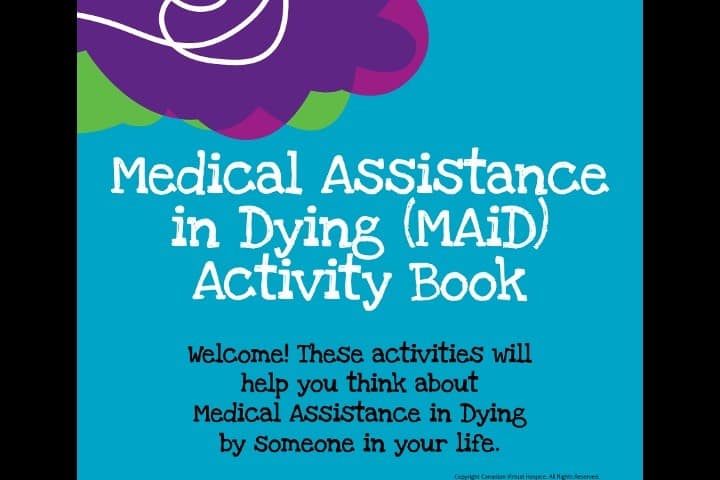
It’s not at all as with the Dutch government, which allows euthanasia for “terminally ill” children under 12. No, Canada’s not killing kids (yet) beyond the womb, but it is, some might say, further initiating them into the culture of death. And it’s doing it by the book.
As The National Post reports:
Just as Ottawa publicly acknowledges that its assisted suicide regime might have gone too far, critics have highlighted the existence of a little-known medical assistance in dying children’s activity book that was funded by the Canadian government.
The Medical Assistance in Dying (MAID) Activity Book was first published in July by the group Canadian Virtual Hospice.
The book is not intended for children who are themselves seeking assisted death, and it’s not subject to mass-distribution through schools or public libraries. Minors are ineligible for medically assisted death in Canada, although there has been a push by the Quebec College of Physicians to extend the practice to severely disabled newborns.
Rather, the activity book is intended for children who may soon be attending a medically assisted death in person. “Created for young people who have someone in their life who may have MAiD,” the group declared in a statement.
MAID is defined in the booklet as the use of medicines to stop a “person’s body from working.”
“When their body stops working, the person dies,” it reads.
The booklet describes MAID as a last-ditch measure reserved only for consenting adults afflicted with an illness or disability that “hurts their body or their mind so much that it feels too hard to keep living.”
A short video presenting the book’s contents is below.
True North adds to the story, writing that the booklet describes “how lethal injection works”:
“The first medicine makes the person feel very relaxed and fall asleep. They may yawn or snore or mumble. The second medicine causes a “coma.” A coma looks like sleep but is much deeper than regular sleep. The person will not wake up or be bothered by noise or touch. The third medicine makes the person’s lungs stop breathing and then their heart stops beating.”
In a section titled: “What if I (or someone else) don’t want them to have MAiD?” the booklet writes: “MAiD is a personal choice. That means that no one can decide for another person. Each person has to decide for themselves.”
The booklet also suggests children to “Draw or write about your ideas and feelings about the person in your life who is choosing MAiD.”
Doctor-assisted suicide was legalized in Canada in 2016 for limited situations, but is expanding at an alarming rate.
This is no exaggeration. As The New American reported in October, Canada is already being called “a world leader in euthanasia,” with the nation — whose population is lower than California’s — killing more than 10,000 people via “assisted” suicide last year alone.
While this itself is striking enough, the system is also apparently being abused. “Canada offered assisted suicide to a Paralympian veteran who wanted a wheelchair lift installed,” according to Fox News on December 3. And Catholic News Agency stated 10 days later that “hungry, poor, and disabled Canadians [are] seeking assisted suicide.”
What’s more, although Canadian law does currently prohibit MAiD for mentally ill people without an “underlying condition,” a mildly “creative” doctor could consider a mentally ill person (e.g., chronically depressed) with diabetes to have a qualifying “underlying condition” — and hence be eligible for euthanasia. This was essentially the case with a 23-year-old Canadian named Kiano Vafaeian.
Addressing this was the executive director of Canadian Physicians for life, Nicole Scheidl, in an interview with True North. Calling the MAiD booklet’s approach “insidious,” she said that its authors characterize euthanasia as “a medical practice and [assert] that medicine is used to euthanize a person.” But it’s not. Rather, it’s “what happens when medicine fails,” she stated. Additionally, Scheidl warned that the booklet misrepresents how euthanasia drugs work and “glosses over” the issues they raise. Its entire goal, she averred, is “normalizing euthanasia.”
To the point here, Scheidl also said that the “medical evidence is overwhelming that determining whether someone will recover from mental illness is impossible to predict.” Nonetheless, “Psychiatrists report that individuals who are suicidal are now no longer accepting treatment as they are waiting for the March expansion of euthanasia,” she continued. After all, Scheidl pointed out, suicidal people generally aren’t rational and can’t see the “light at the end of the tunnel.”
Case in point: I know of a mentally ill man who became suicidal, found an odd character (not a doctor) online who was willing to kill him, and began traveling to that man’s state to have the deed done. Thankfully, rural local police, going beyond their normal role and applying the “higher law” (as they put it), intercepted the fellow and saw to it he was returned to his family. He’s still with us today, many years later, and in a better state of mind (though not perfect). But where might he now be had he legal recourse to euthanasia?
As always, however, this issue relates to far, far deeper ones. That is, the euthanasia movement reflects our discarding of the Christian worldview and the embrace of a secular one.
Christianity acknowledges pain as a cross that we, being human, seek to avoid, of course, but that must not be avoided at any and all costs. As CSLewis.com writes, citing Lewis’s book The Problem of Pain:
When we run headlong into God, Lewis contends that pain is demanded. Why? “How impossible it is to enact the surrender of the self by doing what we like,” he says. The truth is that at the heart of God’s love is a suffering Messiah and followers who take up crosses and follow in like fashion.
“If I knew any way of escape I would crawl through sewers to find it,” Lewis writes. “I am not arguing that pain is not painful. Pain hurts. That is what the word means. I am only trying to show that the old Christian doctrine of being made ‘perfect through suffering’ is not incredible. To prove it palatable is beyond my design.”
Of course, materialists do not, and cannot, thus view the world.
Obviously, this issue can’t be done justice in 160 words. The point is that the philosophical/theological foundation a society embraces determines its fate. The two propositions relevant here — that man is a divine being, flesh and spirit; and that he’s a mere organic robot, some pounds of chemicals and water — suggest very, very different policies. Choose wisely.



